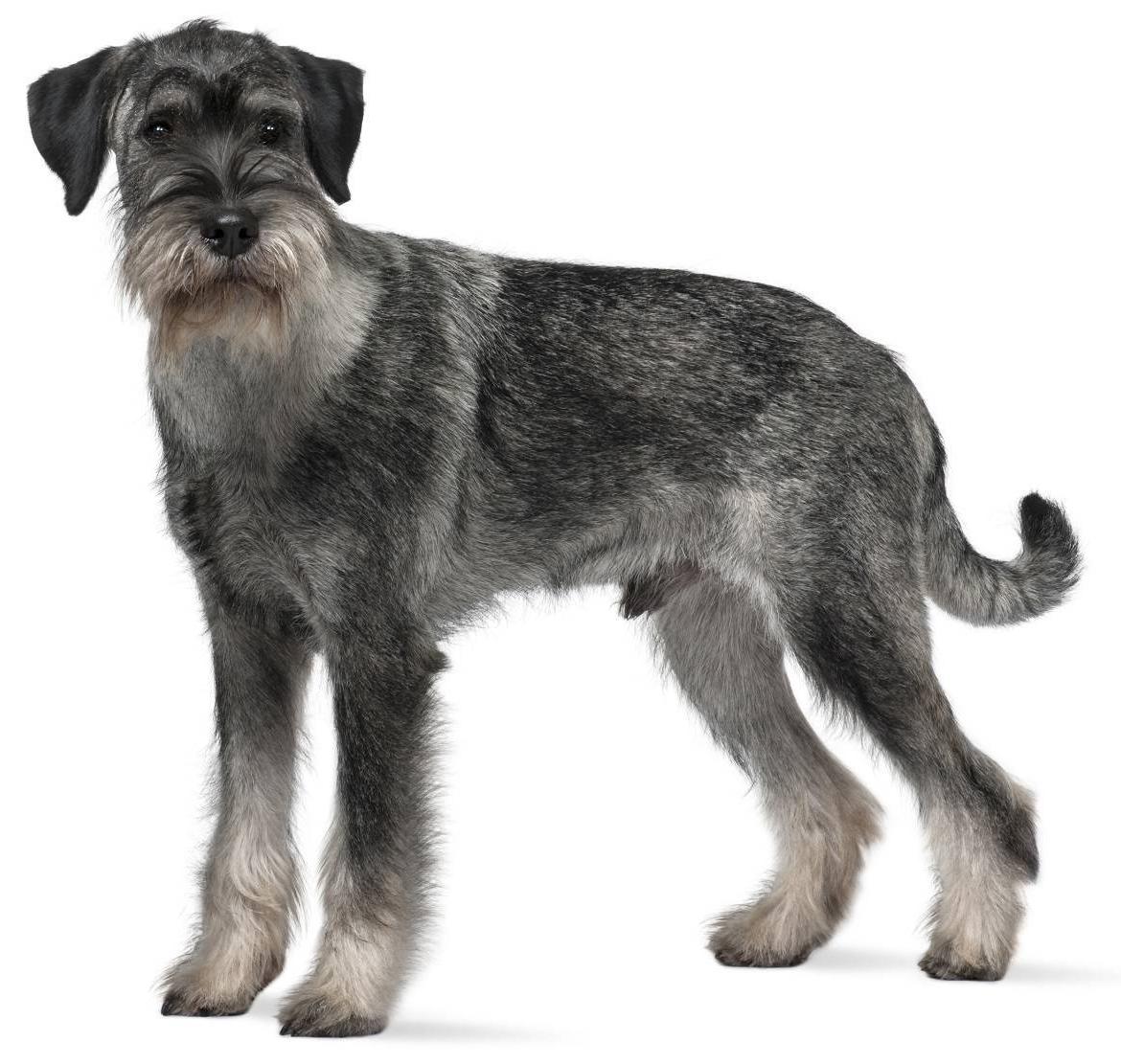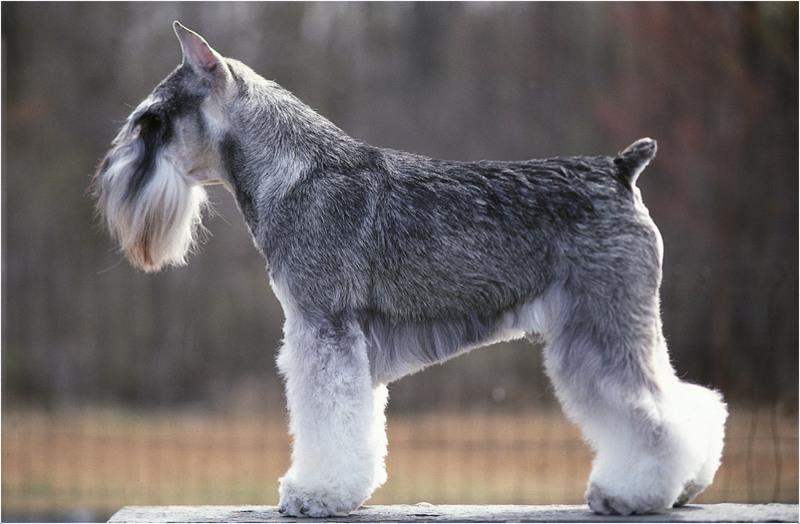- Breed Category: Working Group
- Country of Origin: Germany
- Average Height: 45-50 cm (18-20 inches)
- Average Weight: Males 16-23 kg, Females 14-20 kg
- Average Life Span: 12-15 years
- Grooming Requirements: Regular brushing and trimming
- Exercise Requirements: High, needs daily exercise
- Coat Type: Dense, wiry coat
- Coat Color Variations: Salt and pepper, black
- Shedding Level: Low
- Ear Type: V-shaped, set high
- Tail Type: Set high, carried erect
- Temperament: Alert, spirited, intelligent
- Intelligence Level: High
- Barking Tendency: Moderate
- Compatibility with Children: Good with proper socialisation
- Compatibility with Other Pets: Generally good with other pets
- Training Ease: Highly trainable
- Common Health Issues: Hip dysplasia, eye problems
- Dietary Needs: Balanced diet, high-quality food
- Energy Level: High
- Drooling Tendency: Low
- Sensitivity to Weather: Moderate, needs protection in extremes
- Overall Maintenance Level: Moderate
- Original Purpose: Ratting, guarding, herding
- Year of Recognition by Kennel Clubs: 1904
- Apartment Friendly: Yes, with sufficient exercise
- Best Suited For: Active families, experienced owners
- Cost of Ownership: Moderate to high
- Unique Traits: Distinctive beard and eyebrows
- Popularity Rank: Popular in working breeds
Did you know the Standard Schnauzer is one of the oldest dog breeds, dating back to the 15th century? This versatile breed has a rich history and a distinctive look that sets it apart. Known for their intelligence and spirited nature, Standard Schnauzers are medium-sized dogs with a robust build and a wiry coat. This article aims to inform you about their unique characteristics, fascinating history, and essential care tips.
The Standard Schnauzer originated in Germany, where they were initially bred as rat catchers and guard dogs. Their name comes from the German word “schnauze,” meaning snout, a nod to their prominent bearded muzzle. Over the centuries, they have evolved into loyal companions and skilled working dogs.
Early Development and Historical Significance of the Standard Schnauzer

Early Development of the Breed
The Standard Schnauzer’s journey began in the heart of Germany during the 15th century. Initially, these dogs were bred for their versatility, serving as both rat catchers and guardians of the homestead. Their keen intelligence and adaptability made them invaluable to farmers and tradespeople alike. Over time, their role expanded beyond mere utility, as they became cherished companions and protectors.
Role in European Farming and Guarding
In the bustling farms and towns of Europe, the Standard Schnauzer was a familiar sight. Their robust build and alert nature made them perfect for guarding livestock and property. Farmers relied on their sharp instincts to keep vermin at bay, while their loyalty ensured the safety of the household. This breed’s ability to adapt to various tasks cemented its place in European agriculture and security.
Key Historical Figures and Events
Throughout history, several key figures have contributed to the development of the Standard Schnauzer. Notably, German breeders in the late 19th century played a crucial role in refining the breed’s characteristics. These efforts were pivotal in establishing the breed standard that we recognise today. The breed’s popularity surged after World War I, as returning soldiers brought them home, captivated by their intelligence and charm.
Physical Characteristics
The Standard Schnauzer is easily recognisable by its distinctive appearance. With a sturdy, medium-sized frame, they boast a wiry coat that requires regular grooming. Their most striking feature is the bearded muzzle, which gives them a wise and dignified look. Typically, they have a salt-and-pepper or black coat, and their expressive eyes reflect their spirited and alert nature.
Unique Physical Traits
The Standard Schnauzer stands out with its robust, square build, a testament to its working dog heritage. This breed is medium-sized, striking a perfect balance between strength and agility. Their wiry coat, often in salt-and-pepper or solid black, adds to their rugged charm. The most distinctive feature is their bearded muzzle, which gives them a wise, almost sage-like appearance. Their expressive eyes are full of intelligence and curiosity, always on the lookout for the next adventure.
Temperament and Behaviour
Standard Schnauzers are known for their spirited and lively nature. They are intelligent and quick learners, making them highly trainable. This breed thrives on mental and physical stimulation, so they need plenty of exercise and engaging activities. They are naturally protective, making them excellent watchdogs, yet they are also affectionate and loyal to their families. With the right training and socialisation, they can be both a playful companion and a vigilant guardian.
Personality Traits and Suitability

Typical Personality Traits
Standard Schnauzers are a bundle of loyalty, intelligence, and alertness. These dogs are not just smart; they’re quick thinkers, always ready to learn something new. Their loyalty is unmatched, making them reliable companions who are always on your side. With their alert nature, they make excellent watchdogs, always aware of their surroundings.
Suitability as a Family Pet and Working Dog
These dogs are versatile, fitting seamlessly into family life while also excelling as working dogs. Their protective instincts make them great guardians, yet they’re gentle enough to be around children. Whether you’re looking for a family pet or a working partner, the Standard Schnauzer is up for the task.
Interaction with Children and Other Animals
Standard Schnauzers generally get along well with children, thanks to their playful and affectionate nature. They can also coexist with other animals, especially if socialised from a young age. Their friendly disposition makes them a joy to have around the house.
Training and Exercise Needs
Training a Standard Schnauzer is a rewarding experience due to their intelligence and eagerness to please. They thrive on mental challenges and need regular exercise to keep them happy and healthy. Daily walks, playtime, and training sessions are essential to meet their energetic needs.
Training, Exercise, and Health of the Standard Schnauzer

Importance of Early Training and Socialisation
Getting a head start on training and socialisation is crucial for Standard Schnauzers. These dogs are naturally intelligent and curious, so introducing them to various environments, people, and other animals early on helps shape a well-rounded adult dog. It’s all about setting the foundation for good behaviour and confidence.
Recommended Training Techniques
Positive reinforcement is the way to go with these clever canines. They respond well to rewards and praise, making training sessions enjoyable for both of you. Consistency is key, so keep sessions short and engaging to hold their attention. Remember, they love a challenge, so mix things up to keep them on their toes.
Daily Exercise Requirements and Activities They Enjoy
Standard Schnauzers are energetic and need daily exercise to stay happy and healthy. Think long walks, playtime in the backyard, or even agility training. They love activities that engage both their minds and bodies, so puzzle toys and interactive games are a hit.
Health and Lifespan
With proper care, Standard Schnauzers can live a healthy life of 12 to 15 years. Regular vet check-ups, a balanced diet, and plenty of exercise are essential. Keep an eye out for common breed issues like hip dysplasia and eye conditions, and you’ll have a loyal companion for many years.
Health and Care of the Standard Schnauzer

Common Health Issues
Standard Schnauzers are generally healthy, but like any breed, they can be prone to certain health issues. Keep an eye out for hip dysplasia, eye conditions, and pancreatitis. Regular vet visits can help catch these early, ensuring your Schnauzer stays in top shape.
Average Lifespan and Health Tips
With the right care, these dogs can live between 12 to 15 years. A balanced diet, regular exercise, and mental stimulation are key to a long, healthy life. Don’t forget to keep their weight in check to avoid unnecessary strain on their joints.
Preventative Care Recommendations
Routine vet check-ups are a must. Vaccinations, dental care, and parasite prevention should be part of your regular routine. Early detection of potential issues can make a big difference in your dog’s quality of life.
Grooming and Maintenance
Their wiry coat needs regular grooming to prevent matting. Brushing a couple of times a week and professional grooming every few months will keep them looking sharp. Don’t forget to trim their nails and clean their ears regularly to avoid infections.
Coat Care and Grooming Routines

Shedding and Seasonal Grooming Tips
The Standard Schnauzer’s wiry coat is one of its standout features, but it does require some attention. Regular brushing, at least a couple of times a week, helps keep their coat free of tangles and reduces shedding. During seasonal changes, you might notice an increase in shedding, so a bit more frequent grooming can help manage this. A professional groomer can also assist with hand-stripping, a technique that maintains the coat’s texture and appearance.
Diet and Nutrition
Feeding your Standard Schnauzer a balanced diet is crucial for their overall health and vitality. High-quality dog food, rich in protein and essential nutrients, supports their active lifestyle. Be mindful of portion sizes to prevent obesity, which can lead to joint issues. Fresh water should always be available, and occasional treats can be used for training and rewards. Consulting with your vet can help tailor a diet plan that suits your Schnauzer’s specific needs.
Nutritional Needs and Feeding Guidelines for Standard Schnauzers

Nutritional Needs for Optimal Health
Standard Schnauzers thrive on a diet rich in high-quality protein and essential nutrients. Look for dog food that lists meat as the first ingredient, ensuring they get the energy they need for their active lifestyle. Omega-3 and Omega-6 fatty acids are also beneficial for maintaining their wiry coat and overall skin health.
Foods to Include and Avoid
Include lean meats, fish, and vegetables in their diet for a balanced nutritional profile. Avoid foods high in fat and sugar, as Schnauzers can be prone to pancreatitis. Steer clear of chocolate, grapes, and onions, which are toxic to dogs.
Feeding Schedules and Portion Recommendations
Feed your Schnauzer twice a day to maintain their energy levels and prevent overeating. Portion sizes depend on their age, weight, and activity level, so consult your vet for tailored advice. Always provide fresh water to keep them hydrated.
Fun Facts and Trivia
Did you know that the Standard Schnauzer’s beard isn’t just for looks? It historically protected them from rat bites while working as vermin hunters. Also, their name, “Schnauzer,” comes from the German word for “snout,” highlighting their distinctive facial features.
Interesting Tidbits and Famous Standard Schnauzers
Interesting Tidbits about the Breed
The Standard Schnauzer is a breed full of surprises. Did you know that their distinctive beard wasn’t just for show? Historically, it served a practical purpose, protecting them from bites while they worked as rat catchers. Their wiry coat is not only stylish but also water-resistant, making them well-suited for various weather conditions. These dogs are known for their keen sense of smell, which has made them excellent search and rescue dogs in some parts of the world.
Famous Standard Schnauzers in Media or History
Standard Schnauzers have made their mark in history and media. One notable Schnauzer was George, the beloved pet of President Dwight D. Eisenhower. In the world of fiction, a Standard Schnauzer named Max appeared in the popular children’s book series “The Berenstain Bears.” These dogs have also been featured in various films and TV shows, often portraying loyal and intelligent companions. Their unique look and spirited nature make them a favourite choice for roles that require a dog with character and charm.
Final Thoughts

The Standard Schnauzer is a remarkable blend of intelligence and loyalty. This breed’s rich history and distinctive traits make it a cherished companion and capable working dog. Balancing their spirited nature with proper training and care ensures a rewarding relationship filled with adventure and affection. Embrace the journey of owning a Standard Schnauzer, and you’ll find a loyal friend ready for any challenge. Consider welcoming this versatile breed into your life, and experience the joy they bring.
